

Growth Of Antarctic Sea Ice Due To Fewer Clouds, Chinese Scientists Find. Researchers have discovered that lower cloud coverage in the Antarctic can promote sea ice growth.
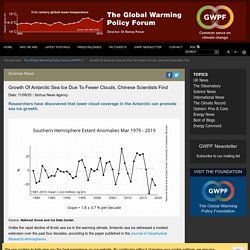
Unlike the rapid decline of Arctic sea ice in the warming climate, Antarctic sea ice witnessed a modest extension over the past four decades, according to the paper published in the Journal of Geophysical Research-Atmospheres. The researchers from China and the United States found that Antarctic sea ice had a strong rebound from 2011 to 2012. “We quantified the effects on sea ice growth via a thermodynamic model based on reanalysis and satellite data and concluded that lower cloud coverage cooled the sea surface and accelerated the sea ice storage,” said Wang Yunhe, a researcher from the Institute of Oceanology, Chinese Academy of Sciences. “Clouds are like a down jacket for the Antarctic to preserve heat during winter,” said Bi Haibo, a researcher from the institute. “Fewer clouds mean more heat is lost from the ocean.” Atmospheric rivers help create massive holes in Antarctic sea ice.
Warm, moist rivers of air may have continent-wide effects and influence climate change Research News.
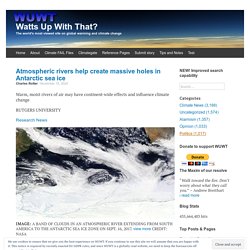
Antarctic Sea Ice Growth Caused by Meltwater. Guest essay by Eric Worrall According to climate scientists, less dense meltwater on the surface of the Antarctic ocean reduced convection between the surface and ocean depths, leaving heat trapped in the depths.
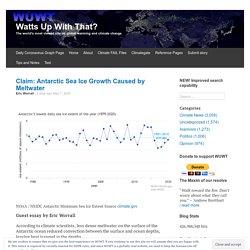
One small area of ocean not changed by global warmingDate:May 6, 2020…Climate and marine scientists are observing pervasive warming of the ocean and the land surfaces across the globe. Since the middle of the 19th century, the average global temperature recorded on the land surface has risen by around one degree centigrade, and by 0.6 degrees across the ocean surface. Global warming has been most pronounced in the alpine regions and the Arctic. Global Warming? “There’s some indication in the data that the pause is leaning toward a small reversal of the 20th-century trends.” Guest essay by Eric Worrall.

New research first to relate Antarctic sea ice melt to weather change in tropics. Diminishing sea ice translates to warmer ocean, more rain, and stronger trade winds University of California – San Diego Arctic and Antarctic ice loss will account for about one-fifth of the warming that is projected to happen in the tropics, according to a new study led by Mark England, a polar climate scientist at Scripps Institution of Oceanography at the University of California San Diego, and Lorenzo Polvani, the Maurice Ewing and J.

Lamar Worzel Professor of Geophysics at Columbia Engineering, England’s doctoral supervisor. Icebergs delay Southern Hemisphere future warming. Institute for Basic Science New research, published today in the journal Nature Climate Change, has found that Antarctic icebergs can weaken and delay the effect of Global Warming in the Southern Hemisphere.

Unabated Global Warming threatens the stability of the Antarctic ice sheet. Recent observations reveal a rapid thinning of the Pine Island and Thwaites glacier regions in Antarctica, which can be attributed partly to warming oceans. Strong Storms Behind Antarctic Ice Shelf Collapse. Published on July 22, 2019 Written by Oregon State University A research team led by U.S. and Korean scientists deployed three moorings with hydrophones attached seaward of the Nansen Ice Shelf in Antarctica’s Ross Sea in December of 2015 and were able to record hundreds of short-duration, broadband signals indicating the fracturing of the ice shelf.
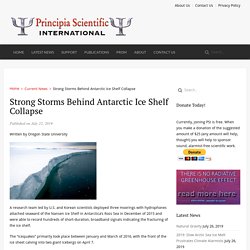
Basal melting of Ross Ice Shelf from solar heat absorption in an ice-front polynya. Study: Fewer Clouds Behind Antarctica's Strong Sea Ice Growth. Published on May 29, 2019 Written by Xinhua Researchers have discovered that lower cloud coverage in the Antarctic can promote sea ice growth.

Unlike the rapid decline of Arctic sea ice in the warming climate, Antarctic sea ice witnessed a modest extension over the past four decades, according to the paper published in the Journal of Geophysical Research-Atmospheres. The researchers from China and the United States found that Antarctic sea ice had a strong rebound from 2011 to 2012. Study: Increase in Antarctic Sea Ice due to changes in cloud cover. 'Remarkable year': What's behind the record low sea ice in Antarctica. It was in early August this year when Phil Reid, a climatologist with the Bureau of Meteorology, first noticed something odd happening to the ice around Antarctica.
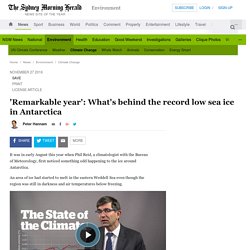
An area of ice had started to melt in the eastern Weddell Sea even though the region was still in darkness and air temperatures below freezing. This is a modal window. This modal can be closed by pressing the Escape key or activating the close button. Caption Settings Dialog Beginning of dialog window. Study: strong El Niño events increase height and mass of Antarctic ice shelves. From UCSD/Scripps Institution of Oceanography New study reveals strong El Niño events cause large changes in Antarctic ice shelves A new study published Jan. 8 in the journal Nature Geoscience reveals that strong El Nino events can cause significant ice loss in some Antarctic ice shelves while the opposite may occur during strong La Nina events.

El Niño and La Niña are two distinct phases of the El Niño/Southern Oscillation (ENSO), a naturally occurring phenomenon characterized by how water temperatures in the tropical Pacific periodically oscillate between warmer than average during El Niños and cooler during La Niñas. The research, funded by NASA and the NASA Earth and Space Science Fellowship, provides new insights into how Antarctic ice shelves respond to variability in global ocean and atmospheric conditions. The study was led by Fernando Paolo while a PhD graduate student and postdoc at Scripps Institution of Oceanography at the University of California San Diego. Why Antarctica's sea ice cover is so low (and no, it's not just about climate change) Sea ice cover in Antarctica shrank rapidly to a record low in late 2016 and has remained well below average. But what’s behind this dramatic melting and low ice cover since? Our two articles published earlier this month suggest that a combination of natural variability in the atmosphere and ocean were to blame, though human-induced climate change may also play a role.
Read more: Record high to record low: what on earth is happening to Antarctica's sea ice? Far Southern Ocean cools. Kiss Goodbye to polar amplication around Antarctica. A map of the sea surface zone that has cooled since 1979 — from 56S – 72S . It’s a pretty big area. Click to enlarge. For years the IPCC have said that warming would be amplified at the poles.
They warned us things would heat up twice as fast, which would melt sea ice. The oceans surface in turn would switch from being reflective white to a dark absorbing deep blue. As the Arctic warmed, the merchants of doom were keen to tell us how how right they were and this was evidence of man-made warming. Claim: wind change around Antarctica may hasten sea level rise. New research shows projected changes in the winds circling the Antarctic may accelerate global sea level rise significantly more than previously estimated. Changes to Antarctic winds have already been linked to southern Australia’s drying climate but now it appears they may also have a profound impact on warming ocean temperatures under the ice shelves along the coastline of West and East Antarctic. “When we included projected Antarctic wind shifts in a detailed global ocean model, we found water up to 4°C warmer than current temperatures rose up to meet the base of the Antarctic ice shelves,” said lead author Dr Paul Spence from the ARC Centre of Excellence for Climate System Science (ARCCSS).
“The sub-surface warming revealed in this research is on average twice as large as previously estimated with almost all of coastal Antarctica affected. Claim: wind change around Antarctica may hasten sea level rise. NASA: Natural Causes Behind Polar Melt. In what amounts to dissension from National Aeronautics and Space Administration (NASA) climate change policy, a series of just-released studies by working-level scientists prove that geological and not atmospheric forces are responsible for melting of Earth’s polar ice sheets. Figure 1. The eruption of Antarctica’s Mount Erebus, one of the continent’s 149 active land volcanoes, many of which lie beneath miles of glacial ice. Low Pressure System Responsible For Lower Antarctic Sea Ice Extent Last Month.
By Paul Homewood A reader, (sorry, forgot who!) , pointed out last month the sharp drop in Antarctic sea ice early in September. It turns out that weather was to blame. From the NSIDC report for September: Antarctic sea ice extent reached 18.44 million square kilometers (7.12 million square miles) on August 31, 2016, and this appears to be the maximum extent for this year. Scientists find ‘natural pulses’ in recent melting of West Antarctic ice sheet. An Ice Shelf Is Cracking In Antarctica, But Not For The Reason You Think. A NASA scientist with project IceBridge took this photo of the crack in November.
John Sonntag/NASA A group of scientists is gathering today in the U.K. to discuss a slab of ice that's cracking in Antarctica. The crack could soon split off a frozen chunk the size of Delaware. One glacier scientist, Heidi Sevestre, spent six weeks last year living on that giant slab of ice off the Antarctic Peninsula. "It's like being on a different planet," says Sevestre, a glaciologist with the University of St Andrews in Scotland. "Everything is gigantic, everything is white," she says. "When you're camping on the ice shelf, you have no idea that you're on something that is floating and moving," she says. The ice shelf is in constant motion: rising with the tides, splitting off icebergs at its edges, and growing again as inland glaciers feed it.
The ice shelf Sevestre was studying is called Larsen C, and it now has a massive 90-mile crack running through it. Antarctic Sea Ice Retreats Due To Wind Patterns. By Paul Homewood While Arctic ice extent has been at low levels lately, coincidentally, strange things have been going on down under. Bipolar disorder – as in the Arctic, the Antarctic sea ice extent is affected by wind, unless of course it’s ‘climate change’ From the “no matter what happens it is climate change” department. So, according to this, when the Arctic loses ice it is due to climate change ‘global warming’ when the Antarctic gains ice it is due to ‘climate change’ and is just as bad. WUWT readers may recall that a few years ago NASA concluded that wind patterns were a major factor in Arctic sea ice loss, pushing the mobile sea ice further south where it melted.
Here’s their press release form 2007. Claim: New Antarctic sea-ice extent due to wind and ‘atmospheric warming’ – what warming? Larsen C Ice Shelf Crack Not Related To Climate Change …Ice “More Stable Than Previously Thought” By Dr. Sebastian Lüning and Prof Fritz Vahrenholt (German text translated/edited by P Gosselin) Image: visibleearth.nasa.gov. Surprise: Antarctic Ice Shelves Growing, Variations Linked To Natural Ocean Cycles, Unrelated To ‘Global Warming’